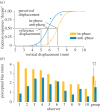The brain uses extrasomatic information to estimate limb displacement
- PMID: 26311672
- PMCID: PMC4571714
- DOI: 10.1098/rspb.2015.1661
The brain uses extrasomatic information to estimate limb displacement
Abstract
A fundamental problem faced by the brain is to estimate whether a touched object is rigidly attached to a ground reference or is movable. A simple solution to this problem would be for the brain to test whether pushing on the object with a limb is accompanied by limb displacement. The mere act of pushing excites large populations of mechanoreceptors, generating a sensory response that is only weakly sensitive to limb displacement if the movements are small, and thus can hardly be used to determine the mobility of the object. In the mechanical world, displacement or deformation of objects frequently co-occurs with microscopic fluctuations associated with the frictional sliding of surfaces in contact or with micro-failures inside an object. In this study,we provide compelling evidence that the brain relies on these microscopic mechanical events to estimate the displacement of the limb in contact with an object, and hence the mobility of the touched object. We show that when pressing with a finger on a stiff surface, fluctuations that resemble the mechanical response of granular solids provoke a sensation of limb displacement. Our findings suggest that when acting on an external object, prior knowledge about the sensory consequences of interacting with the object contributes to proprioception.
Figures




Similar articles
-
The Change in Fingertip Contact Area as a Novel Proprioceptive Cue.Curr Biol. 2016 May 9;26(9):1159-63. doi: 10.1016/j.cub.2016.02.052. Epub 2016 Apr 7. Curr Biol. 2016. PMID: 27068417 Free PMC article.
-
Does the location of the touch from the contralateral finger application affect grip force control while lifting an object?Neurosci Lett. 2007 Oct 2;425(3):151-5. doi: 10.1016/j.neulet.2007.07.048. Epub 2007 Aug 9. Neurosci Lett. 2007. PMID: 17850968
-
Influence of fingertip contact on illusory arm movements.J Appl Physiol (1985). 2004 Apr;96(4):1555-60. doi: 10.1152/japplphysiol.01085.2003. Epub 2003 Dec 29. J Appl Physiol (1985). 2004. PMID: 14698993
-
Coding and use of tactile signals from the fingertips in object manipulation tasks.Nat Rev Neurosci. 2009 May;10(5):345-59. doi: 10.1038/nrn2621. Epub 2009 Apr 8. Nat Rev Neurosci. 2009. PMID: 19352402 Review.
-
Peripheral mechanisms of touch and proprioception.Can J Physiol Pharmacol. 1994 May;72(5):484-7. doi: 10.1139/y94-071. Can J Physiol Pharmacol. 1994. PMID: 7954077 Review.
Cited by
-
Touch as an auxiliary proprioceptive cue for movement control.Sci Adv. 2019 Jun 5;5(6):eaaw3121. doi: 10.1126/sciadv.aaw3121. eCollection 2019 Jun. Sci Adv. 2019. PMID: 31183406 Free PMC article.
-
Tactile contribution extends beyond exteroception during spatially guided finger movements.Sci Rep. 2025 Apr 29;15(1):14959. doi: 10.1038/s41598-025-99503-w. Sci Rep. 2025. PMID: 40301588 Free PMC article.
-
An elasticity-curvature illusion decouples cutaneous and proprioceptive cues in active exploration of soft objects.PLoS Comput Biol. 2021 Mar 22;17(3):e1008848. doi: 10.1371/journal.pcbi.1008848. eCollection 2021 Mar. PLoS Comput Biol. 2021. PMID: 33750948 Free PMC article.
-
Rapid change of friction causes the illusion of touching a receding surface.J R Soc Interface. 2023 Feb;20(199):20220718. doi: 10.1098/rsif.2022.0718. Epub 2023 Feb 8. J R Soc Interface. 2023. PMID: 36751927 Free PMC article.
-
Neuromorphic Vibrotactile Stimulation of Fingertips for Encoding Object Stiffness in Telepresence Sensory Substitution and Augmentation Applications.Sensors (Basel). 2018 Jan 17;18(1):261. doi: 10.3390/s18010261. Sensors (Basel). 2018. PMID: 29342076 Free PMC article.
References
-
- Jami L. 1992. Golgi tendon organs in mammalian skeletal muscle: functional properties and central actions. Physiol. Rev. 72, 623–666. - PubMed
Publication types
MeSH terms
LinkOut - more resources
Full Text Sources
Other Literature Sources
Medical

